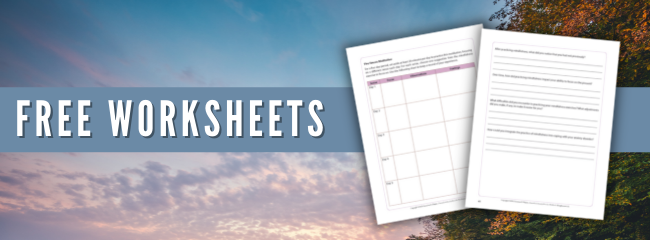Being Mindful with the 5 Senses
Free exercise to reduce anxiety and engage with the present moment!

Anxiety disorders can demand that we ignore what is taking place around us by bombarding our minds with disturbing thoughts, urges, and images. These unwanted experiences distract us from living our lives in the moment and instead encourage us to obsess about a past we cannot change and an uncertain future we cannot predict or control. But what if we tried to live our lives according to the uplifting and freeing principles of mindfulness instead of the rigid rules of our anxiety disorders?
Mindfulness exercises encourage clients to notice and accept their thoughts without obsessing over them. By teaching them to focus on the present moment in a meaningful, nonjudgmental way, it takes the power away from their anxious thoughts.
Have your clients commit to using their sense of sight, sound, touch, taste, and smell to channel their thoughts in a purposeful direction. Begin by focusing on one sense for at least one to two minutes, taking the time to truly separate that sense from the next as they move from one to the other.
It does not matter in what order a client practices the five senses; the order can be switched around as each person sees fit. If a client cannot or does not want to exercise certain senses, these can be skipped. They can sit in a comfortable position the first few times, and as they become accustomed to the exercise, they can engage in it at any time or place.
At first this exercise may seem silly and even somewhat difficult, but as clients continue to practice, they will find it easier to incorporate mindfulness into their daily experience until it becomes a natural part of who they are.
Download this free worksheet to help your clients keep track of their sense-based mindfulness over the course of a week’s time. They’ll get the hang of it in no time and be more tuned to their observations and feelings with just a little meditation every day.
For more exercises that can help to manage Generalized Anxiety Disorder and stress in general, check out my new book, Generalized Anxiety Disorder Workbook: CBT Activities to Manage Anxiety, Cope with Uncertainty, and Overcome Stress
Mindfulness exercises encourage clients to notice and accept their thoughts without obsessing over them. By teaching them to focus on the present moment in a meaningful, nonjudgmental way, it takes the power away from their anxious thoughts.
Have your clients commit to using their sense of sight, sound, touch, taste, and smell to channel their thoughts in a purposeful direction. Begin by focusing on one sense for at least one to two minutes, taking the time to truly separate that sense from the next as they move from one to the other.
Five Senses Mindfulness Exercise Examples
Sight
- Observe what is around you, noticing shapes, colors, and textures.
- Look for things you would not usually take the time to notice, such as shadows, a crack in the sidewalk, the texture of your bedspread, or any other small details that usually escape you.
Sound
- Take the time to listen to what is in the background instead of what is obvious.
- Don’t just notice the sound of laughter, but try to discern different types of laughs.
- Rather than simply listening for the sounds of traffic, try to distinguish horns honking from tires squealing.
- Instead of becoming upset by loud music, take the time to figure out what genre you are hearing.
- Listen to previously unnoticed sounds, like the hum of the refrigerator or the clicking of the oven as it cycles on and off.
Touch
- Become aware of the differing feel of everyday items that surround you.
- Alternate touching items that are cold and warm, and notice how they make your hands feel.
- Touch items with various textures and notice the differences among them.
- Knit, play with modeling clay, or pet an animal, and feel the sensations in your fingers and hands as you feel the motions unfold.
Taste
- Take a drink, and notice the feel of the liquid rolling over your tongue.
- Chew on a piece of gum or candy, and take the time to notice the taste from when you first put it in your mouth until you are finished with it.
Smell
- Focus your attention on your surroundings to notice what different smells are in the air.
- Keep strong-smelling gum or candy with you to center yourself when you feel your anxiety rising.
- Items such as lavender, perfume, or lotion can also provide a satisfying aroma that invokes mindfulness.
It does not matter in what order a client practices the five senses; the order can be switched around as each person sees fit. If a client cannot or does not want to exercise certain senses, these can be skipped. They can sit in a comfortable position the first few times, and as they become accustomed to the exercise, they can engage in it at any time or place.
At first this exercise may seem silly and even somewhat difficult, but as clients continue to practice, they will find it easier to incorporate mindfulness into their daily experience until it becomes a natural part of who they are.
Download this free worksheet to help your clients keep track of their sense-based mindfulness over the course of a week’s time. They’ll get the hang of it in no time and be more tuned to their observations and feelings with just a little meditation every day.
For more exercises that can help to manage Generalized Anxiety Disorder and stress in general, check out my new book, Generalized Anxiety Disorder Workbook: CBT Activities to Manage Anxiety, Cope with Uncertainty, and Overcome Stress
Break Free From The Cycle of Worry

Is worry taking over your life? Are you constantly worrying about money, health, family, work, or other issues? Do you find it difficult to control your worries even though you know they are not helping you?
Although anxiety can make it seem like things will never get better, it is possible to break free from the cycle of worry. In the Generalized Anxiety Disorder Workbook, Dr. Lawrence Shapiro provides you with the tools you need to stop battling against your worries and strip anxiety of its power. Filled with a variety of straightforward and easy-to-use worksheets, you’ll learn how to:
Although anxiety can make it seem like things will never get better, it is possible to break free from the cycle of worry. In the Generalized Anxiety Disorder Workbook, Dr. Lawrence Shapiro provides you with the tools you need to stop battling against your worries and strip anxiety of its power. Filled with a variety of straightforward and easy-to-use worksheets, you’ll learn how to:
- Identify your worry triggers
- Tolerate uncomfortable thoughts and feelings
- Manage catastrophic thinking
- Incorporate mindfulness into your routine
- Cope with intrusive thoughts
- Develop new positive habits
Meet the Expert:
Lawrence E. Shapiro, PhD, is a prolific author of self-help books and the inventor of more than 100 therapeutic games. Dr. Shapiro is known for his practical approach to helping others. He has written workbooks, storybooks, card games, board games, and smartphone apps. His work has been translated into 27 languages.
Learn more about their educational products, including upcoming live seminars, by clicking here.
Learn more about their educational products, including upcoming live seminars, by clicking here.




